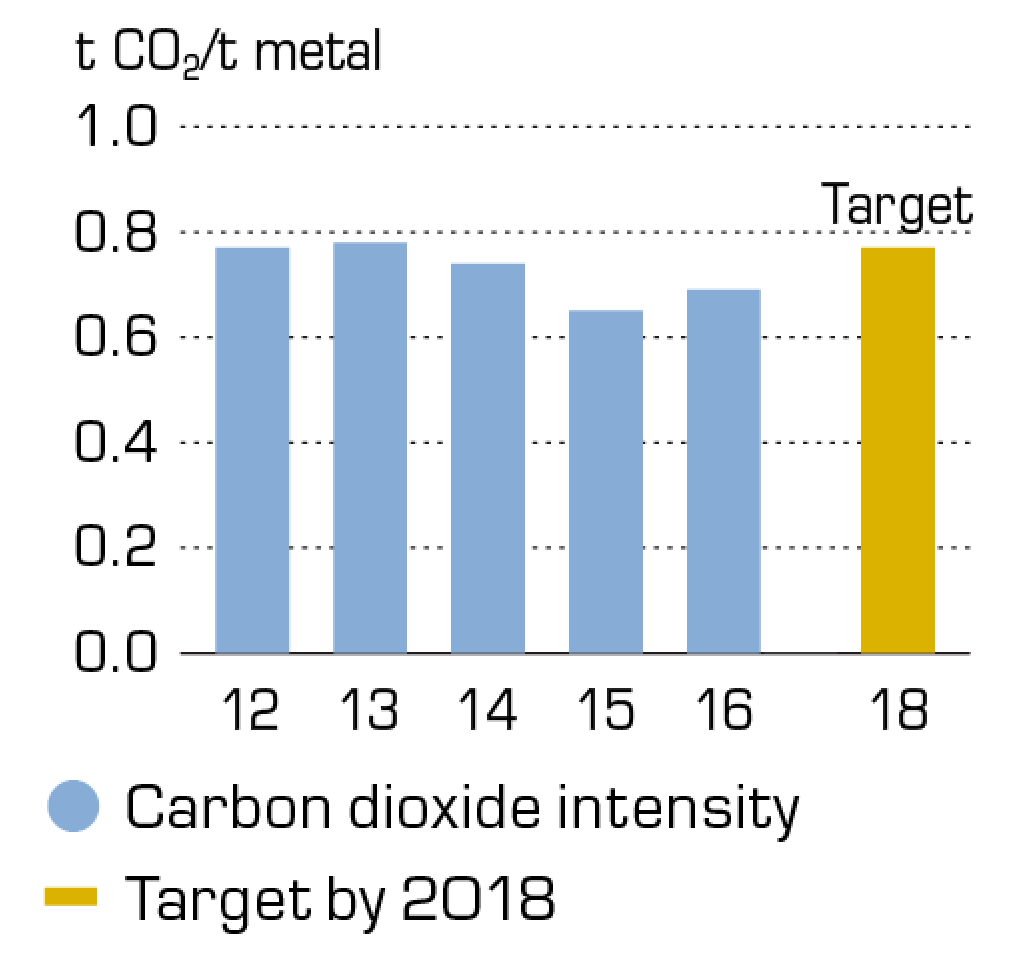Performance 2016
Metal discharges to water

Results 2016
The environmental impact from discharges of metals to water (metal equivalents) has declined by 40% since the base year of 2012. The discharges of metals with high toxicity (mercury, cadmium and arsenic) decreased in 2016. Rönnskär’s new water treatment plant enables reduced discharges of metals, e.g. zinc and lead.
Comments
Since 2015, Boliden has been reporting the impact of metal discharges as metal equivalents, a method, whereby the various elements are allocated a power factor, depending on how toxic they are to the aquatic environment. The method is based on copper equivalent toxicity (as if the toxicity were only caused by Cu). This method has been used retroactively in this report since 2012.
Boliden also reports water discharges in accordance with GRI, see indicator EN22.
Metals emissions to air

Results 2016
The environmental impact from emissions of metals (metal equivalents) to air has increased by 9% since the base year of 2012. Emissions of copper, mercury and cadmium have decreased, while emissions of lead increased during the year.
Comments
Since 2015, Boliden has been reporting the impact of metal emissions as metal equivalents, a method, whereby the various elements are allocated a power factor, depending on how toxic they are to humans exposed to them. The method is based on copper equivalent toxicity (as if the toxicity were only caused by Cu). This method has been used retroactively in this report since 2012.
Boliden also reports emissions in accordance with GRI, see indicator EN21.
Sulphur dioxide emission

Results 2016
Emissions of sulphur dioxide to air have declined by 14% in comparison with the base year of 2012. The year on year decrease is mainly due to Boliden’s investment in a new converter at the Kokkola smelter.
Comments
Sulphur dioxide is currently within the internal targets, but performance is uneven due to some installations approaching a point where re-investment is required. Boliden’s investment in a new sulphuric acid plant in Harjavalta is expected to contribute to a further decline in sulphur dioxide emissions in the coming years. See indicator EN21 for more information.
Carbon dioxide emissions

Results 2016
The carbon dioxide intensity has increased from 0.65 to 0.69 as a result of Kevitsa being integrated in the Boliden Group. The increase is due to production, including concentration, being more energy-intensive in an open pit mine and to indirect carbon dioxide emissions being higher for Finnish electricity production than for the average of Boliden’s other units.
Comments
The relative emissions of carbon dioxide shall stabilize to the 2012 level (0.77 t CO₂⁄t metal), regardless of increased production. To achieve this Boliden has to work with energy efficiency and technological development. See indicators EN3-6 and EN 15-19 to learn more about Bolidens work related to carbon dioxide.
Environmental accidents

Results 2016
The number of environmental incidents has increased to 1.4 (1.2) per month. 17 (14) environmental incidents occurred in 2016. Nine of the events involved discharges to water, five involved prohibited air pollution, and two involved waste handling. None of the above incidents are adjudged to have caused lasting damage or significant environmental impact. One incident involved a violation of the Cultural Environment Act and is described in EN-DMA and EN-29.
Comments
Boliden has changed the title of the key performance indicator in 2016, from environmental accidents to environmental incidents, because the majority of the incidents do not result in any significant environmental impact. Reducing the number of environmental incidents demands efficient systems at every stage of the value chain, but also requires a focused way of working with routines, risk assessments, action plans and advanced technology.
